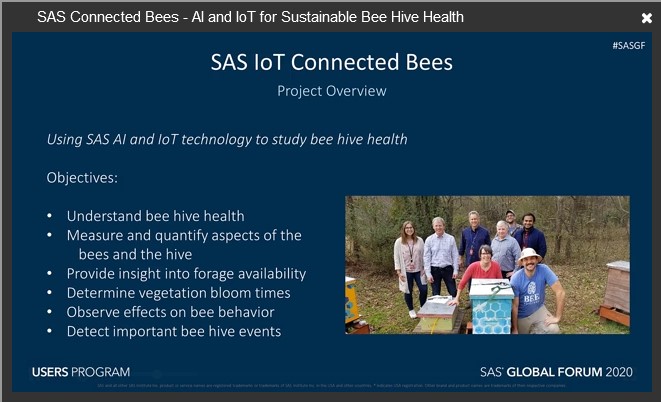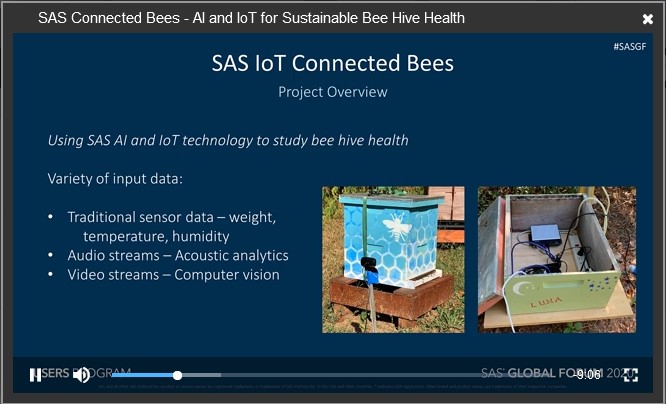Like most conferences this year, the 2020 SAS Global Forum (SGF) went virtual. The analytics giant staged a one-day online event offering all of the components SAS users expect from the in-person conference (except, of course, the food and drink). Pictured above, SAS founder and CEO Jim Goodnight.
The venue

Whoever put the virtual environment together had obviously learned from some of the less than wonderful efforts that have been foisted on us over the last few months. The SGF interface was clean and easy to navigate, and audio in sessions was clear. That’s an improvement over some other events whose audio and video was choppy because of poor presenter Internet connections.
The keynote

SAS founder and chief executive officer Dr. Jim Goodnight kicked things off talking about the impact of COVID-19 on SAS and its customers. “We soon saw the need for data and analytics across all industries as organizations started to respond to COVID-19,” he noted. The company has built models to help organizations in areas like hospitals, retail, manufacturing, logistics, supply chain, public sector, and others respond to the pandemic, and has made them freely available to all. It is also offering 30 days of free access to its online training materials.
The biggest announcement, aside from the partnership with Microsoft revealed on Monday, was around the upcoming release of SAS Viya 4. It will be cloud-native, yet will run on-prem or as a service if desired, developer friendly and automated. Public APIs will allow it to be embedded in other applications.
SAS itself is in good shape, Goodnight said in an interview. It will not lay anyone off during the pandemic. “Although our revenue is down about six per cent this year, so are our expenses because we’re not travelling,” he said. “We have a pretty good supply of money in the bank. We’ll be OK.”
Tracking the spread

SAS director of public service and financial practice Steve Bennett, who leads the company’s COVID-19 response, took the stage to explain how analytics helped Manila in the Philippines predict where the COVID-19 hot spots would be by tracking citizen movement patterns against infections. In partnership with Globe Telecom, it took aggregated data from mobile communications and cell towers and mapped movement, correlating it with infection patterns. By the week of April 19, the model’s predictions for the following week’s infections were 94 – 97 per cent accurate. He also demonstrated automatic contact tracing that illustrates how quickly networks of contacts can be assembled and examined using a lightweight mobile interface for SAS Visual Investigator compared to manual methods.
Principles of analytics

“SAS is an analytics company, and we have an internal compass that orient and guides us. I call it the principles of analytics, they inform our approach and they manifest themselves as technology and markets change over time,” said executive vice-president, chief operating office and chief technology officer Oliver Schabenberger (pictured above).
Those three principles:
- Analytics follows data; analytics everywhere. Data without analytics is value not yet realized.
- Analytics is more than algorithms; the value lies in solving data-driven problems.
- Democratization; analytics for everyone. Organizations will not benefit from the impact of digital transformation unless data and analytics can scale beyond the data science team. We need to enable and empower everyone.
The virtual expo

Every SAS conference has an expo known as The Quad, where customers can see SAS and partner solutions, view short video presentations, and interact with experts. The virtual Quad offered all of those things, including the ability to have online chats with booth staff, Ask the Experts sessions, and links to additional resources. A virtual briefcase provided a handy place to stash interesting tidbits and links to intriguing content.
Unlike some other virtual conferences that had cluttered streaming chat that was virtually impossible to follow, the SGF provided the ability to have 1:1 chats. And. Of course, there was a trivia game, with the top 20 scorers winning a SAS swag bag.
The Lounge

The lounge provided a comfy virtual space for education, community interaction meetings, and more. It also linked to the free SAS COVID-19 models.
The buzz on IoT

Attendees didn’t just see the traditional use of analytics. SAS products contribute to all sorts of unusual areas, for example, using streaming video and more to monitor beehives.
SAS’s genesis over 40 years ago was in agriculture, so distinguished research statistician developer Anya McGuirk’s presentation in the SAS Connection auditorium (there were also two Superdemos in the Quad that got into the technical details) spoke to the company’s heritage. They showed how SAS is researching the monitoring of beehives to detect issues before the bees die. Honeybees are responsible for pollinating most of our food crops, yet more than 40 percent of beehives in the U.S. were lost last year, making the research important to agriculture.
Connected Bees

SAS houses four beehives on its campus in Cary, North Carolina, and all of them are instrumented with cameras, microphones, a scale, temperature sensors, and more. SAS Viya processes the inputs and notifies beekeepers in real time if a hive needs attention – for example, a change in internal hive temperature has been shown to indicate that the queen has stopped laying eggs, or that swarming is imminent. In the course of the work, the researchers have discovered hitherto unknown things about bees and have published on the subject.
The technology and techniques, it turns out, can also be applied to asset management in the industry.
